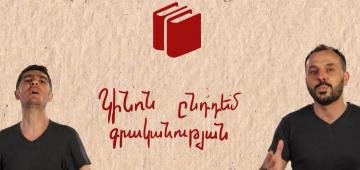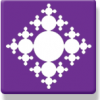 |
About one story: O. Henry, "The Gift of the Magi"Christmas and the mysteries of this bright holiday have found their artistic expression in works of Armenian and world literature, but there is one story where the spiritual significance of the holiday is expressed in a unique way. O. Henry's famous story "The Gift of the Magi" is discussed by literary critics Hayk Hambardzumyan and Arkmenik Nikoghosyan. |
 |
Cinema vs. Literature: Part 2Do unsuccessful film adaptations of literature harm literature, how and by what principles is film adaptation evaluated, and what does it give to literature? These questions are discussed in parallel by literary critics Hayk Hambardzumyan, Arkmenik Nikoghosyan, and film critic Karen Avetisyan. |
 |
Cinema for the sake of literature: part 1
Film adaptations are one of the most diverse, creative connections and remarkable manifestations of relationships between fiction and cinema. Are film adaptations of famous literary works made for the sake of literature, do they contribute to a new reading and recognition of literature, do they stimulate reading, or, nevertheless, does cinema solve its own problems? Literary critics Hayk Hambardzumyan, Arkmenik Nikoghosyan, and film critic Karen Avetisyan discuss the topic in parallel.
|
 |
Daniel Varuzhan- the song of the BreadDaniel Varuzhan's last, miraculously saved and posthumously published, remarkable series "The Song of Bread" presents the process of bread creation, from sowing to baking. This poetic series has powerful ideological and psychological charges and important goals. In the "Parallel Readings" program, D. Varuzhan's "The Song of Bread" series is discussed by literary critics Hayk Hambardzumyan and Arkmenik Nikoghosyan. |
 |
Within a story, Stepan Zoryan, "Fence"
Perhaps the most famous story of the famous prose writer, “The Fence”, at first glance, tells about a simple everyday quarrel that disrupts people's relationships, affects their inner world and psychology. However, this simple story provides an opportunity for deeper analysis. Stepan Zoryan's story “The Fence” is discussed by literary critics Hayk Hambardzumyan and Arkmenik Nikoghosyan on the “Parallel Readings” program.
|
 |
Family sagas in Armenian literature
In world literature, the family saga, as a form within the novel's genre, is quite well-known and widespread, and such masterpieces as Thomas Mann's "The Buttenbrooks" or Emily Bronte's "The Tale of the Wind in the Wind" are just such realizations. But it is also a fact that the family saga is not characteristic of the literature of all peoples. What is the uniqueness of this genre, do we have family sagas in Armenian literature? Literary critics Hayk Hambardzumyan and Arkmenik Nikoghosyan discuss the program "Parallel Readings".
|
 |
Aznavour, a memoirist and a novelist
Charles Aznavour has written remarkable memoirs, autobiographies, even short stories and a novel. What is unique about his published prose? Literary critics Hayk Hambardzumyan and Arkmenik Nikoghosyan discuss the program "Parallel Readings"
|
 |
The Poet Aznavour
We cannot imagine the words of Charles Aznavour's famous songs without the accompaniment of a melody, but the words of hundreds of Aznavour's songs can also be read as poetry. Can we talk about the poet Aznavour and what are the characteristics of these poems? Literary critics Hayk Hambardzumyan and Arkmenik Nikoghosyan discuss these issues in the program "Parallel Readings".
|
 |
About a story: Sergey Dovlatov, “The Colonel Said I Love You”
In the story “The Colonel Said I Love You” by the famous prose writer Sergey Dovlatov, the author records, through small episodes of a certain person’s life and lifestyle, the lack of motivation to live in a Soviet country, the uncertainty of life, the absence of prospects, and the control of the authorities over all of this. Literary critics Hayk Hambardzumyan and Arkmenik Nikoghosyan discuss the story on the “Parallel Readings” program.
|
 |
Love in Poetry
These delicate and captivating works on the theme of love in Armenian medieval literature, the poetry, amaze readers with their psychological depth and multi-layeredness, the simplicity of their forms of expression, and the immediacy of their feelings. Literary critics Hayk Hambardzumyan and Arkmenik Nikoghosyan discuss the love homelands on the program “Parallel Readings.”
|
 |
A Completely Different Autumn
The “autumn” tones of Armenian classical poetry continue in the poems of Soviet Armenia and the period of independence. Although the moods and themes remain the same, the “autumn” of literature is enriched with new motifs and forms of expression. In the program “Parallel Readings”, literary critics Hayk Hambardzumyan and Arkmenik Nikoghosyan discuss the autumn layers of Armenian literature.
|
 |
Whisper and rustle in the autumn mist
It seems that autumn is the most favorite season of poets, but this has not been the case in all periods of literary history. When and how did autumn become poetic, why are there no autumn images in medieval poetry, and what is the significance of this season in romantic and symbolist poetry? Literary critics Hayk Hambardzumyan and Arkmenik Nikoghosyan discuss the topic in the program "Parallel Readings".
|
